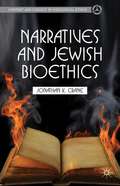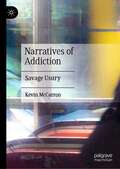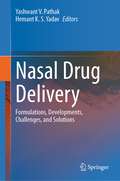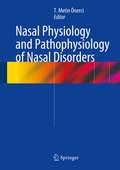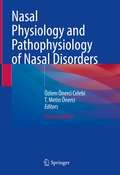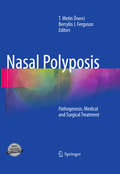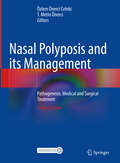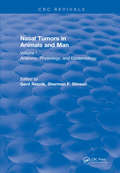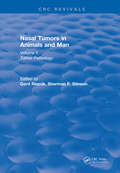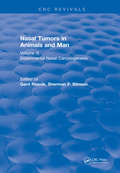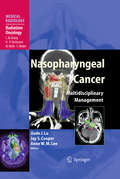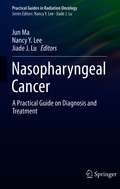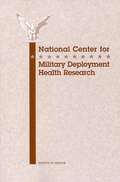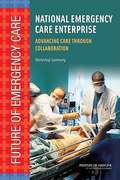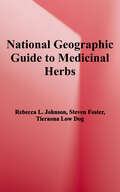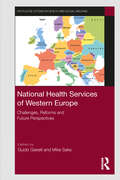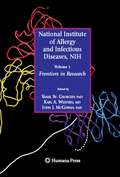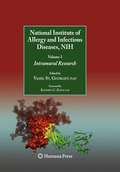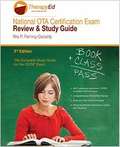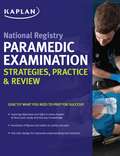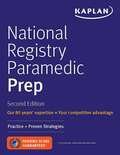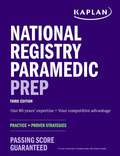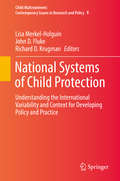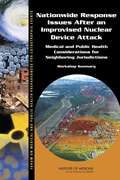- Table View
- List View
Narratives and Jewish Bioethics
by Jonathan K. CraneNarratives and Jewish Bioethics searches for answers to the critical question of what roles ancient narratives play in creating modern norms by Jewish bioethicists utilizing the Jewish textual tradition.
Narratives of Addiction: Savage Usury
by Kevin McCarronNarratives of Addiction: Savage Usury is the first book to argue, in the face of more than a century’s received wisdom, that drug addiction and alcoholism are undoubtedly evidence of individual moral flaws. However, the sense of morality that underlies this book is completely severed from Christianity. Instead, it is influenced in particular by the writings of the nineteenth-century German philosophers Arthur Schopenhauer and Frederick Nietzsche, both of whom insisted that a genuine morality was actually incompatible with Christianity. The sequence of chapters moves from addictions on the streets, into rehab clinics, and finally into the meetings of Alcoholics Anonymous and Narcotics Anonymous. This is the first book to argue that the search for pleasure drives alcoholism and drug addiction and not the “numbing of pain”. Throughout the book I reject the claims of the medical profession, as embodied by the American Medical Association, that drug addiction and alcoholism are diseases, and further argue that they do not have the authority to tell hundreds of millions of Americans that addiction is not a moral failing. I also query throughout the book the claims of neuroscience, psychology, and the social sciences that addictions to alcohol and drugs are attributable to causes that their specific disciplines are best suited to understand. I argue that there is nothing complex about addiction: it is a simple behavioural disorder. The language routinely employed to discuss addiction is similarly not complex, just confused, and so it is also the rhetoric of addiction discourse, especially its use of simile, metaphor and euphemism, that this book evaluates.
Nasal Drug Delivery: Formulations, Developments, Challenges, and Solutions
by Yashwant V. Pathak Hemant K. S. YadavThis book addresses the recent trends and clinical research being reported in last 5 to 10 years in the field of nasal drug delivery systems. In recent years, interest in using nasal passage as drug absorption site has received increased attention from formulation scientists. Nasal passages, even though a small surface area of the body as compared to other absorption passage such as Gastrointestinal tract or skin, show significant possibility for drug absorption at a quicker rate. There is also a possibility of delivering drugs to the brain using this passage and targeting drugs through the nasal passage. The book has 19 chapters addressing various aspects of nasal drug delivery systems such as an overview of anatomy and physiology of the nasal passage from a drug delivery point of view to global market opportunities for nasal drug delivery. In between, it addresses various aspects of nasal drug delivery. There are very few titles exclusively dedicated to nasal drug delivery, covering the formulation and developmental aspects, and addressing the challenges and solutions. The primary audiences for the book are graduate students in field of medicine, pharmacy and also various researchers who are working in the area of nasal drug delivery in addition to students who are specializing in field of medicine in ENT. This book provides comprehensive information on all the aspects related to the nasal drug delivery of various drug molecules.
Nasal Physiology and Pathophysiology of Nasal Disorders
by T. Metin ÖnerciNasal physiology and pathophysiology is a relatively neglected area, yet without a deep knowledge of the physiology it is impossible to understand the impact of structural changes and the process of disease development or to make sound treatment decisions. With the help of numerous tables, schematic drawings, and color photographs, this book will enable the reader to understand the nasal physiology and pathophysiology in detail. All four functions of the nose - respiration, defense, olfaction, and cosmesis - are covered. Each chapter addresses one important aspect in an accessible way, and each is written by an acknowledged expert on the topic under consideration. The various techniques of clinical evaluation of nasal function are fully discussed, and current trends and future directions in nasal physiologic research are also explored. This book will be of value to both practicing otorhinolaryngologists and novices in the field.
Nasal Physiology and Pathophysiology of Nasal Disorders
by T. Metin ÖnerciNasal physiology and pathophysiology is a relatively neglected area, yet without a deep knowledge of the physiology it is impossible to understand the impact of structural changes and the process of disease development or to make sound treatment decisions. With the help of numerous tables, schematic drawings, and color photographs, this book will enable the reader to understand the nasal physiology and pathophysiology in detail. All four functions of the nose – respiration, defense, olfaction, and cosmesis – are covered. Each chapter addresses one important aspect in an accessible way, and each is written by an acknowledged expert on the topic under consideration. The various techniques of clinical evaluation of nasal function are fully discussed, and current trends and future directions in nasal physiologic research are also explored. This book will be of value to both practicing otorhinolaryngologists and novices in the field.
Nasal Physiology and Pathophysiology of Nasal Disorders
by T. Metin Önerci Özlem Önerci CelebiThis fully revised and expanded second edition provides a comprehensive and up-to-date overview of nasal physiology and pathophysiology. With the help of numerous tables, schematic drawings, and color photographs, it helps readers gain a better understanding of the impact of structural changes and the process of disease development, and to make treatment decisions. Each chapter has been written by a leading expert in the field and addresses one important aspect in an accessible way. Covering all four functions of the nose: respiration, defense, olfaction and cosmesis, the book discusses the various techniques for the clinical evaluation of nasal function as well as current trends and future directions in nasal physiologic research. This second edition also includes additional chapters on rhinomanometry, local nasal inflammation, T cells and B cells, and artificial intelligence for the nose. Given its scope, the book is a valuable resource for both experienced otorhinolaryngologists and novices in the field.
Nasal Polyposis
by T. Metin Önerci Berrylin J. FergusonNasal polyposis is seen in many disease states, including allergic and non-allergic rhinitis. Since the quality of life for patients afflicted with this condition decreases, such patients frequently seek medical help. Further, the relationship between the upper and lower respiratory tract makes the treatment of nasal polyposis of critical importance. New research findings, as well as new technical developments, have changed the conventional medical and surgical approaches to treating nasal polyposis, the result of which has been significant advances in the management of the disease. This book, written by authors internationally recognized for their laboratory research and clinical practice, is lavishly illustrated and reader-friendly. It includes the latest information on nasal polyposis, and aims to help the reader improve the daily management of patients affected by this condition.
Nasal Polyposis and its Management: Pathogenesis, Medical and Surgical Treatment
by T. Metin Önerci Özlem Önerci CelebiThis fully revised and expanded second edition provides a comprehensive and up-to-date overview of nasal rhinitis polyposis, a condition that not only decreases patients’ quality of life, but also affects the connections between the upper and lower respiratory tract, making its treatment of critical importance. New research findings, as well as new technical innovations, have changed the conventional medical and surgical approaches to the treatment of nasal polyposis, which has resulted in significant advances in the management of the disease. This reader-friendly and richly illustrated book gathers contributions by authors internationally recognized for their outstanding laboratory research and clinical practice. This second edition includes the latest information, together with new chapters on nasal polyposis endotyping, Asian polyps, epithelial barrier in nasal polyposis, biologics of nasal polyposis, microbiome of nasal polyposis, eosinophil & nasal polyposis, nasal polyposis in children, staphylococcus aureus, superantigens and nasal polyps, and antifungal treatment in chronic sinusitis. It offers comprehensive information to help readers improve the daily management of patients affected by nasal polyposis.
Nasal Tumors in Animals and Man Vol. I: Anatomy, Physiology, and Epidemiology (CRC Press Revivals)
by Sherman F. Stinson D. V. M. Gerd ReznikThis Monograph brings together within one cover the current knowledge about tumors of the nasal passages in man, in domestic and nondomestic animals, and in the rodents which are commonly employed in carcinogenesis studies in the laboratory.
Nasal Tumors in Animals and Man Vol. II: Tumor Pathology (CRC Press Revivals)
by Gerd Reznik Sherman F. StinsonThis Monograph brings together within one cover the current knowledge about tumors of the nasal passages in man, in domestic and nondomestic animals, and in the rodents which are commonly employed in carcinogenesis studies in the laboratory.
Nasal Tumors in Animals and Man Vol. III: Experimental Nasal Carcinogenesis (CRC Press Revivals)
by Gerd Reznik D. V. M. Stinson Sherman F.This Monograph brings together within one cover the current knowledge about tumors of the nasal passages in man, in domestic and nondomestic animals. and in the rodents which are commonly employed in carcinogenesis studies in the laboratory.
Nasopharyngeal Cancer
by Jay S. Cooper Anne W. Lee Jiade J. LuNasopharyngeal Cancer - Multidisciplinary Management provides a comprehensive account of the current state of knowledge on nasopharyngeal cancer and its multidisciplinary management. The first ten chapters document contain essential background information on subjects such as epidemiology, pathogenesis, molecular biology, pathology, and the use of imaging in diagnosis and staging. Subsequently, the various treatment options and combinations in a range of settings are examined in depth. Detailed attention is given to the roles of concurrent, adjuvant, and neoadjuvant chemotherapy and advanced radiotherapy techniques. Further chapters then explore surgical treatment, follow-up, treatment of metastatic disease, treatment-related complications, and nasopharyngeal cancer in children. This is an important book that will prove essential reading for the radiation oncology community worldwide and meet the need for substantial improvements in knowledge of modern techniques.
Nasopharyngeal Cancer: A Practical Guide on Diagnosis and Treatment (Practical Guides in Radiation Oncology)
by Jun Ma Jiade J. Lu Nancy Y. LeeThis book provides up-to-date guidance that will assist radiation oncologists during the day-to-day management of nasopharyngeal cancer. After discussion of diagnosis and staging, target delineation techniques and treatment planning are described for both intensity-modulated and particle radiation therapy. Detailed information is then presented on the application of radiation therapy in different disease settings, from early stage disease to metastatic disease. Due attention is paid to the role of multimodality treatment and new and advanced technologies in particular circumstances, such as local recurrence. In addition, follow-up and the management of late toxicities are explained and management strategies are documented for special situations and groups, including pediatric patients. The book is published within the Springer series Practical Guides in Radiation Oncology. Like other volumes in the series, it is designed for hands-on use by both radiation oncology residents and practicing radiation oncologists. It will also be of value for head and neck physicians.
National Center for Military Deployment Health Research
by Committee on a National Center on War-Related Illnesses Postdeployment Health IssuesThe National Academies Press (NAP)--publisher for the National Academies--publishes more than 200 books a year offering the most authoritative views, definitive information, and groundbreaking recommendations on a wide range of topics in science, engineering, and health. Our books are unique in that they are authored by the nation's leading experts in every scientific field.
National Emergency Care Enterprise: Advancing Care through Collaboration - Workshop Summary
by Institute of Medicine of the National AcademiesIn 2006, the Institute of Medicine (IOM) released a series of three books on the Future of Emergency Care in the United States Health System. These reports contained recommendations that called on the federal government and private stakeholders to initiate changes aimed at improving the emergency care system. Three years later, in May 2009, the IOM convened a workshop to examine the progress to date in achieving these objectives, and to help assess priorities for future action. The May 2009 workshop, summarized in this volume, brought stakeholders and policy makers together to discuss which among the many challenges facing emergency care are most amenable to coordinated federal action. The workshop sought to foster information exchange among federal officials involved in advancing emergency care and key stakeholder groups from around the country.
National Geographic Guide to Medicinal Herbs: The World's Most Effective Healing Plants
by Steven Foster Rebecca L. Johnson Tieraona Low Dog"This excellent guide is the work of a team of highly qualified botanical and medical experts, including two of my colleagues from the Arizona Center for Integrative Medicine. It offers reliable, up-to-date, practical information about 72 of the most important medicinal herbs." --Andrew Weil, M.D., from the Foreword. There is a world of health and healing all around you--in your spice rack, your backyard, and on the shelves of health food and grocery stores. This informative guide is a reference you will keep at the ready, connecting 72 of the world's most common and useful medicinal herbs with the body systems they help and heal.Eight chapters focus on body systems:1. Mental Health & the Nervous System2. Respiratory System3. Heart & Circulation4. Digestive System5. Joints, Muscles & Skin6. Urinary & Male Health7. Female Health8. Wellness & PerceptionEach chapter begins with an overview of how plants can bring health to that part of the body, with stories about traditional herbal remedies from around the world and current scientific findings on herbal remedies for specific illnesses. Then each chapter highlights nine plants, combining botanical and medical information--therapeutic uses, effectiveness, preparations, cautions, and advice, including a round-up of current science about the active ingredients in the plant. Every chapter includes a photo gallery showing how one of its herbs is cultivated and processed commercially--the story behind the contents of that bottle you buy in the store. Special features include "Over the Kitchen Counter"--quick and easy ways to use herbs in your everyday life, and time lines for every herb, showing how today's use of herbal remedies collects wisdom from the centuries and around the world. A functional appendix includes an illustrated index to all the plants in the book, an ailment-by-ailment therapeutic index, a glossary, and an index.
National Health Services of Western Europe: Challenges, Reforms and Future Perspectives (Routledge Studies in Health and Social Welfare)
by Mike Saks Guido GiarelliThis book draws on research within neo-Weberian and neo-institutionalist perspectives to critically analyse National Health Services (NHSs) in Western Europe. Exploring the challenges posed by neo-liberal policies, it also looks at the impact of the role of the state, the medical profession, the public and the medical–industrial complex in their development. Bringing together a top-line range of expert international contributors, this book includes national studies from three European macro-regions: Britain, Scandinavia and the Mediterranean. In the first part, the NHSs of each country considered are examined historically and in a contemporary context in face of emerging challenges – from cost containment to governance. The second part looks across the macro-regions at the influence of the main actors involved in their evolution and sustainability. Comparing and contrasting the NHSs of Western Europe, the book ends with a discussion of future directions. This book makes a vital contribution at a time when health services globally have been under great pressure in the wake of the COVID-19 pandemic. It is written for academics and advanced students of healthcare, management, public policy, social policy and sociology – in addition to health professionals and policymakers.
National Institute of Allergy and Infectious Diseases, NIH
by John J. Mcgowan Vassil St. Georgiev Karl WesternFor over 50 years, the mission of the National Institute of Allergy and Infectious Diseases (NIAID) has been to conduct and support basic and applied research to better understand, treat, and prevent infectious, immunologic, and allergic diseases with the ultimate goal of improving the health of individuals in the United States and around the world. As part of its mission to foster biomedical discovery and to reduce the burden of human disease, NIAID is committed to encouraging the accelerated translation of biomedical discoveries into effective clinical care and public health practice throughout the world. In pursuit of this goal and its disease-specific scientific objectives, NIAID seeks to broaden research opportunities and collaborations involving scientists and institutions outside the United States. National Institute of Allergy and Infectious Diseases, NIH: Volume 1, Frontiers in Research contains presentations given at the 2006 NIAID Research Conference held in Opatija, Croatia which brought internationally known researchers from the United States and Central and Eastern Europe to focus together on shared interests in microbiology, infectious disease, HIV/AIDS, and basic and clinical immunology. Some of the topics covered include emerging and re-emerging infections, the development of infectious disease prophylactics and therapeutics, drug resistance, and various topics in immunomodulation, autoimmunity, infections and immunity, and the development of vaccines. Extensive and in-depth, National Institute of Allergy and Infectious Diseases, NIH: Volume 1, Frontiers in Research is a valuable, comprehensive guide to the state of research today.
National Institute of Allergy and Infectious Diseases, NIH
by Vassil St. GeorgievNational Institute of Allergy and Infectious Diseases, NIH: Volume III: Intramural Research contains a broad overview of the research activity of the NIAID intramural scientists working in the Division of Intramural Research (DIR) and the Vaccine Research Center (VRC), both in the Bethesda campus, and the Rocky Mountains Research Laboratories. Each of these laboratories employs scientists internationally recognized as leaders in their fields of biomedical research. This volume focuses on individual research contributions by internationally known scientists doing research in the NIAID laboratories.
National Occupational Therapy Assistant Certification Exam Review and Study Guide (3rd Edition)
by Rita P. Fleming-CastaldyThe TherapyEd National Occupational Therapy Assistant Certification Exam Review and Study Guide is designed to assist graduates of accredited occupational therapy assistant (OTA) education programs in their preparation for the National Board for Certification in Occupational Therapy examination for certified occupational therapy assistants. This Review and Study Guide provides a comprehensive overview of the depth and breadth of current occupational therapy practice according to the field's seminal textbooks, the American Occupational Therapy Association's Practice Framework, Guide to Occupational Therapy Practice, and Standards of Practice. The text chapters cover all of the practice domains established by the NBCOT's most current examination blueprint.
National Registry Paramedic Examination Strategies, Practice & Review
by Kaplan MedicalFor the first time, study with Kaplan for the National Registry Paramedic Examination! Kaplan has brought its time-tested review practices to the National Registry Paramedic Exam (NRPE). Emergency response careers are on the rise with more and more EMTs moving up into paramedic positions, yet there is little guidance available to students preparing for the national exam. NRPE Strategies, Practice & Review is a comprehensive study tool designed to tackle the NRPE head-on. Content is presented in dynamic, reader-friendly sections with hundreds of full-color figures and tables to improve understanding and retention. Kaplan’s NRPE Strategies, Practice & Review provides test-taking strategies and review for this complex exam. This first edition features: * Overview of the NRPE and test-taking strategies * Content weighted to match the NRPE * Concise review of the material tested on the exam, including: Physiology, Pharmacology, Respiratory Emergencies, Cardiac Emergencies, Shock, Trauma, Obstetrics and Gynecology, Pediatrics, the Psychomotor Exam, and more! * Board-style Q&A with detailed answer explanations in each chapter * Full-color figures and tables to aid in understanding and retention
National Registry Paramedic Prep: Practice + Proven Strategies (Kaplan Test Prep)
by Kaplan MedicalKaplan's National Registry Paramedic Prep provides essential content and focused review to help you master the national paramedic exam. This second edition features comprehensive content review, board-style practice questions, and test-taking tips to help you face the exam with confidence.Essential ReviewContent is weighted to match the NRP so you can focus your study where it counts the mostConcise review of the material tested on the exam, including physiology, pharmacology, respiratory emergencies, cardiac emergencies, shock, trauma, obstetrics and gynecology, pediatrics, the psychomotor exam, and moreFull-color figures and tables to aid in understanding and retentionRealistic practice questions with detailed answer explanations in each chapterOverview of the exam to help you avoid surprises on test dayExpert GuidanceWe invented test prep—Kaplan (www.kaptest.com) has been helping students for 80 years, and our proven strategies have helped legions of students achieve their dreams
National Registry Paramedic Prep: Practice + Proven Strategies (Kaplan Test Prep)
by Kaplan MedicalKaplan's National Registry Paramedic Prep provides essential content and focused review to help you master the national paramedic exam. This new edition features comprehensive content review, board-style practice questions, and test-taking tips to help you face the exam with confidence.Essential ReviewNew EMS Operations chapter with practice questionsConcise review of the material tested on the NRP exam, including physiology, pathophysiology, pharmacology, cardiology, respiratory and medical emergencies, shock, trauma, obstetrics and gynecology, pediatrics, the psychomotor exam, and moreFull-color figures and tables to aid in understanding and retentionRealistic practice questions with detailed answer explanations in each chapterOverview of the exam to help you avoid surprises on test dayExpert GuidanceWe invented test prep—Kaplan (www.kaptest.com) has been helping students for 80 years, and our proven strategies have helped legions of students achieve their dreams
National Systems of Child Protection: Understanding the International Variability and Context for Developing Policy and Practice (Child Maltreatment #8)
by Richard D. Krugman Lisa Merkel-Holguin John D. FlukeThis volume provides a wide spectrum description analysis of the contemporary and well established child protection systems in a range of countries, such as Australia, Canada, Netherlands and Spain. It presents a brief orientation about the public and private systems involved in protecting children in each country. Further the book identifies current key policy and implementation drivers that orient the systems of child protection, such as children’s rights, family preservation, use of evidence and public health orientation. Finally it presents a critical analysis of the strengths and limitations of the systems, as well as, strategies for prospects for improving outcomes for children and their families.
Nationwide Response Issues After an Improvised Nuclear Device Attack
by Institute of Medicine Board on Health Sciences Policy Forum on Medical and Public Health Preparedness for Catastrophic Events Miriam Davis Bruce Altevogt Megan ReeveOur nation faces the distinct possibility of a catastrophic terrorist attack using an improvised nuclear device (IND), according to international and U.S. intelligence. Detonation of an IND in a major U.S. city would result in tens of thousands to hundreds of thousands of victims and would overwhelm public health, emergency response, and health care systems, not to mention creating unprecedented social and economic challenges. While preparing for an IND may seem futile at first glance, thousands of lives can be saved by informed planning and decision making prior to and following an attack. In 2009, the Institute of Medicine published the proceedings of a workshop assessing the health and medical preparedness for responding to an IND detonation. Since that time, multiple federal and other publications have added layers of detail to this conceptual framework, resulting in a significant body of literature and guidance. However, there has been only limited planning effort at the local level as much of the federal guidance has not been translated into action for states, cities and counties. According to an informal survey of community preparedness by the National Association of City and County Health Officials (NACCHO), planning for a radiation incident ranked lowest in priority among other hazards by 2,800 local health departments. The focus of Nationwide Response Issues After an Improvised Nuclear Device Attack: Medical and Public Health Considerations for Neighboring Jurisdictions: Workshop Summary is on key response requirements faced by public health and health care systems in response to an IND detonation, especially those planning needs of outlying state and local jurisdictions from the detonation site. The specific meeting objectives were as follows: - Understand the differences between types of radiation incidents and implications of an IND attack on outlying communities. -Highlight current planning efforts at the federal, state, and local level as well as challenges to the implementation of operational plans. -Examine gaps in planning efforts and possible challenges and solutions. -Identify considerations for public health reception centers: how public health and health care interface with functions and staffing and how radiological assessments and triage be handled. -Discuss the possibilities and benefits of integration of disaster transport systems. -Explore roles of regional health care coalitions in coordination of health care response.
